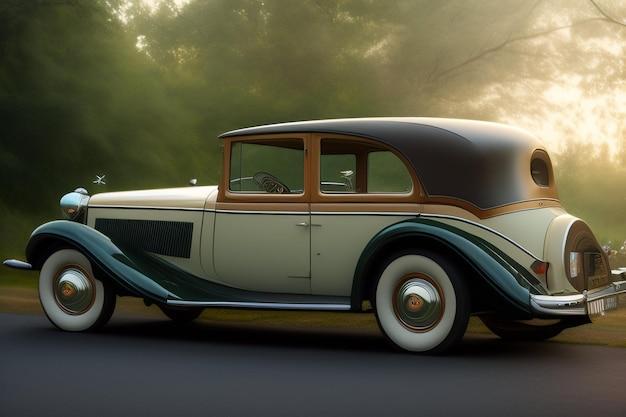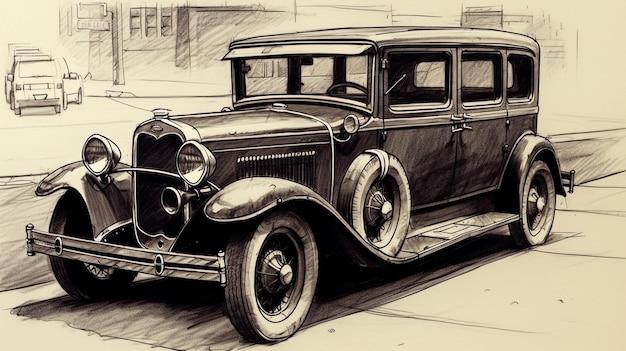The roaring 1920s were a time of rapid change and innovation, and the automotive industry was no exception. With the introduction of affordable mass-produced automobiles like the Ford Model T, cars became more accessible to the average person. But just how fast could these early cars go?
In this blog post, we will delve into the speed capabilities of cars in the 1920s, exploring their top speeds and comparing them to cars from other decades. From the iconic Model T to luxurious race cars, we’ll uncover the thrilling world of automotive speeds in the 1920s and beyond.
So buckle up and get ready for a journey through time as we explore the fascinating world of 1920s cars and their speed prowess.

How Fast Were 1920s Cars
The roaring 1920s were known for their iconic fashion, lively jazz music, and the birth of the automobile era. But just how fast did those classic cars of the 1920s go? In this article, we’ll dive into the speed limits of the era, the fastest cars of the time, and the thrilling experience of driving these vintage vehicles.
Speed Limits: Taming the Crazy
Although the 1920s marked a time of rebellion and the desire for freedom, speed limits during this era were still relatively conservative. In most areas, the average speed limit ranged from 25 to 35 miles per hour, which may seem sluggish by today’s standards. But in a time when roads were often unpaved and conditions unpredictable, it was all about safety first – and preserving the delicate balance between freedom and chaos.
The Need for Speed: Fastest Cars of the Roaring 20s
While speed limits may have been modest, car enthusiasts of the time still craved thrilling accelerations and heart-pounding top speeds. Several automakers rose to meet this demand by manufacturing cars that pushed the boundaries of velocity. One such legend was the iconic Model T by Ford, reaching a top speed of around 45 miles per hour. If you were fortunate enough to get your hands on a powerful Stutz Model AA, you could experience speeds of up to 70 miles per hour – enough to turn heads and create quite the dust storm!
The Joy of Wind in Your Hair: The Experience of Driving a 1920s Car
Driving a car in the 1920s was an experience unlike any other. Picture yourself sitting behind the wheel, fingers gripped firmly around the steering wheel, as the open road beckons. The engine hums, and with a gust of wind, you’re off on an adventure. Although the speed may seem modest by today’s standards, the thrill of the wind rushing through your hair, the rumble of the road beneath you, and the pure freedom of exploration made every journey an exhilarating escapade.
The Legacy Lives On
As time moves forward, the legacy of the 1920s cars lives on. Vintage car collectors and enthusiasts continue to cherish these mechanical marvels, preserving their rich history and stunning craftsmanship. The romance and nostalgia of cruising in a classic 1920s car, evoking images of the Great Gatsby and an era of elegance, will forever hold a special place in the hearts of people who appreciate the golden age of automobiles.
While the 1920s may have been a time of modest speed limits and relatively slower cars compared to today, the fascination and allure of these vintage vehicles remain timeless. The roaring 20s may have given birth to the automobile era, but it also shaped our collective imagination of driving with wind in our hair and a sense of freedom like no other. So, the next time you see a beautifully restored 1920s car cruising down the street, take a moment to appreciate the history, the craftsmanship, and the joy it brings to those fortunate enough to experience it.

FAQ: How Fast Did 1920s Cars Go
The 1920s were an exciting period in automotive history, with new advancements in technology and a growing need for speed. If you’re curious about how fast cars could go during this time, you’re in the right place! In this FAQ-style guide, we’ll answer some of the most frequently asked questions about the speed of 1920s cars. So buckle up and let’s take a joyride through the roaring twenties!
What was the top speed of a 1908 Ford Model T
The iconic Ford Model T, introduced in 1908, was a true trailblazer in the automotive industry. While it wasn’t the fastest car of its time, it could still reach an impressive top speed of around 45 miles per hour (72 kilometers per hour). So, you might not have been able to break any land speed records, but you could definitely get around with a little pep in your step!
How fast did cars go in 1900
Ah, the turn of the century. Cars were still in their early stages of development, so don’t expect any Bugatti Veyron-like speeds here. Back in 1900, the average car could reach a modest speed of around 30 miles per hour (48 kilometers per hour). It may not sound like much compared to modern vehicles, but at the time, it was quite the thrill!
How fast did a 1934 Ford go
In 1934, Ford introduced the stylish and powerful Ford V8. This beauty of a car could hit speeds of up to 75 miles per hour (120 kilometers per hour). That’s pretty impressive for the 1930s! The Ford V8 brought speed and style together, making it a hit among car enthusiasts of the time.
How fast was a Ford Model A
The Ford Model A, produced from 1927 to 1931, was another popular model from the Ford Motor Company. This classic car had a top speed of around 65 miles per hour (105 kilometers per hour). While not the fastest car on the block, it still provided a thrilling driving experience for its lucky owners.
How fast did a Model T go
The Ford Model T, roaring onto the scene in the early 1900s, revolutionized the automobile industry. This iconic vehicle had a top speed of approximately 45 miles per hour (72 kilometers per hour). While it may not seem impressive by today’s standards, it was a game-changer during its time and brought car ownership to the masses.
What was the fastest car in 1920
Now, this is where things get exciting! In the 1920s, one car stole the spotlight as the fastest of its time—the Duesenberg Model J. With its powerful engine, this luxury automobile could reach top speeds of up to 119 miles per hour (192 kilometers per hour). Talk about living life in the fast lane!
How fast did race cars go in 1927
Race cars in 1927 were lightning-fast compared to regular passenger vehicles. During this time, some race cars could reach speeds of around 130 miles per hour (209 kilometers per hour). That’s faster than most of us would dare to drive today, even on a racetrack!
How fast did early cars go
As the automobile industry was still in its infancy, early cars had more modest speeds. In the late 1800s and early 1900s, cars typically achieved speeds between 10 and 30 miles per hour (16-48 kilometers per hour). While it may seem slow in comparison to modern vehicles, these early cars were pioneers that paved the way for the speed demons we have today.
Can a car go 300 mph
While many modern supercars can easily reach speeds over 300 miles per hour, it’s not a feat that could be accomplished by cars in the 1920s. During that time, cars were not built to achieve such incredible speeds. However, technological advancements and fierce competition in the following decades would eventually make 300 mph a reality for some lucky enthusiasts.
What was the first car to go 100 mph
The honor of being the first car to hit the magical 100 mph mark goes to the “Blitzen” Benz. This record-breaking automobile, designed by German engineer Fritz von Opel, achieved a top speed of 125 miles per hour (201 kilometers per hour) in 1909. Back then, reaching such incredible speeds was quite the jaw-dropping spectacle!
How fast were cars in the 1950s
The 1950s marked a time of great innovation in the automotive industry. The average car during this era could reach speeds of around 90 miles per hour (145 kilometers per hour). Car design and engineering were evolving rapidly, paving the way for the stylish and speedy vehicles we know today.
What was the fastest car in 1940
In the 1940s, the automobile industry was focused more on the war effort than pushing the limits of speed. However, one car stood out as a high-velocity marvel—the 1940 BMW 328. This sleek and sporty car could reach an impressive top speed of 96 miles per hour (155 kilometers per hour). Its aerodynamic design and powerful engine made it a force to be reckoned with.
How fast could cars go in the 1960s
The 1960s were a decade of muscle cars and rebellious spirit. During this time, some of the most iconic American muscle cars were hitting the streets. Cars like the Chevrolet Camaro and Ford Mustang could reach speeds of around 120 miles per hour (193 kilometers per hour). It was a wild era for car enthusiasts with a need for speed!
How fast could cars go in the 1940s
In the 1940s, car speeds were somewhat limited due to the ongoing war effort. Most cars had a top speed of around 80 miles per hour (129 kilometers per hour), focusing more on efficiency and reliability than outright speed. However, as the war came to an end, automotive innovation would take off and bring about a new era of faster cars.
How fast is a 1920s race car
Race cars of the 1920s were exhilarating speed demons on the tracks. These roaring machines could achieve top speeds of around 140 miles per hour (225 kilometers per hour). They were the ultimate expressions of speed during this era, captivating audiences with their thrilling performances.
What car can go 325 mph
Today, there are a select few hypercars that can reach the mind-boggling speed of 325 miles per hour (523 kilometers per hour). Notable examples include the Bugatti Chiron Super Sport 300+ and the Hennessey Venom F5. These extreme machines push the boundaries of what’s possible, offering true speed demons a taste of adrenaline like no other.
Get ready to hit the gas!
And there you have it—the most burning questions about the speed of 1920s cars answered! From the iconic Ford Model T to the lightning-fast Duesenberg Model J, the 1920s were a decade of automotive innovation and excitement. So, whether you’re a history buff or simply fascinated by the world of vintage automobiles, these FAQs have given you a glimpse into the thrilling world of 1920s car speeds. Strap on your driving gloves, rev up your engines, and enjoy the ride through automotive history!
*[F1]: Formula One